Memory conflicts on social media: a Twitter data analysis
Fourth report (2021) by Celeste Muñoz Martínez
Data collection by Mariluz Congosto
Previous considerations
In this fourth report, corresponding to the second half of 2020, we continued the analysis of Twitter contents that relate the past and the present in the form of commemorations and anniversaries. The social significance surrounding these events, their reconstructions and attributions, are part of the sociology of our societies; they act as a catalyst for the conflicts that take place in a historical logic and they can be a double-edged sword in their resolutions. While many different agents and processes take part in the genesis of these uses, during recent years social networks have taken on a key role in the spread of the current debates accompanying these processes, as well as a space for transformation —as we have seen. For this reason, this project seeks to continue exploring these situations, entering its third year in 2021 with additional tools and perspectives to conduct these interpretations.
For this report, we can reveal some new information, and also share continuities that allow us to retrace the comparative and evolutionary perspective of some of these celebrations. On a European level, we have continued with the analysis of “Day of Remembrance for Victims of Totalitarian Regimes” (August 23rd), which is the second year it has been included in this report. We have also incorporated the “Day of Hispanicity” (October 12th), which although not an eminently European celebration —as it is only celebrated in the Spanish state—, it has a huge international impact on social networks, especially following #BlackLivesMatter and the iconoclastic phenomena that occurred in Europe and America against the statues of Columbus and other colonisers. The subversion of this memory and the appearance of opposing celebrations, such as the “Day of Indigenous Resistance” in Bolivia, or the challenge phenomenon, must be read as a social change with the rise of decolonial and activist movements. That is why we believe that the incorporation of this date can contribute many tools towards understanding this present. Finally, we have added the “Day of Remembrance for Victims of the Franco Regime” (October 31st) to the study. This new celebration seeks to establish a memory of the dictatorship, escaping the rhetoric of reconciliation and comparison; but to date it has a low social presence. Analysing it is an opportunity to determine the level of acceptance and socialisation of these initiatives outside the institutional framework during this embryonic stage.
In these preliminary considerations we cannot ignore the social and health context in which the world is currently immersed, and which evidently affects the use of social networks. This element undoubtedly affects the interpretation of data, as we saw in the previous report on “Europe Day”. The COVID-19 crisis has immersed Europe and the world in a wave of confinements, a rupturing of social relationships and trauma. It has profoundly affected our relationship with social networks, which have become much closer and even, at times, have become the only channel of socialisation. Since March there are more people online, seeking contact and social interaction, but there is also more information variety [1]. There has been an increase in the number of users, but also in the amount of time spent on social networks and the amount of Fake News. It has become a challenge for society to face, addressing information overload and the strict consumption of information [2].
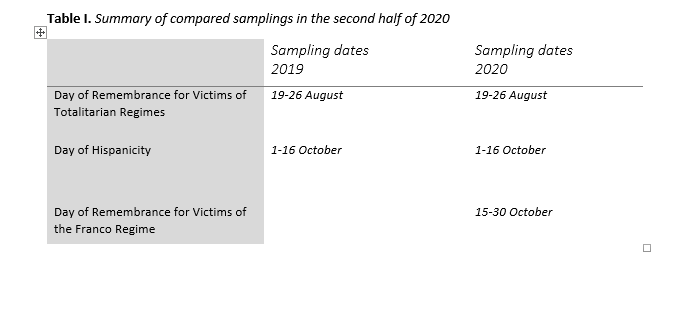
Methodology and sociological profile
For this section, we refer to the first report of this series. The methodology and the sociological profiles are maintained for the second half of the year and will be updated in the 2021 reports with the final data from 2020 [3].
Individual readings
European Day of Remembrance for Victims of All Totalitarian and Authoritarian Regimes
As mentioned in the previous analysis, the Day of Remembrance for Victims of Totalitarian Regimes is held on the August 23rd, the date of the signing of the Molotov-Ribbentrop Pact between the USSR and Nazi Germany in 1939. It is a very controversial celebration with a recurring debate about the political justifications legitimising it and because of the veiled comparison between communism and Nazism as political regimes. On a methodological level, the data for this analysis were obtained through a combination of webscraping and API monitoring, and they reveal a similar trend to 2019. Firstly, as a result of the reach, as it included a decrease in the number of contents generated. In 2019 a total of 4,527 tweets were reecorded (with a reach of up to 23,054 through RT). In 2020, on the other hand, there were 3,993 (with a reach of up to 33,188 through RT). It is still, therefore, a celebration with a very reduced impact on social networks. Secondly, because there continues to be a hybridisation with other celebrations held that day, especially the Baltic Way, and on a secondary plane, with the anniversary of the Hong Kong revolts. Although compared to the previous year, changes were also observed. The first is the appearance of negationists of victims of Stalinism. The second is the reduction of the presence of profiles from Hong Kong demanding their “Baltic Way”. The third is a greater presence of Spanish profiles.
On this occasion, we have broadened the linguistic spectrum of the searches, aware of the relevance of this data in Eastern Europe. Tweets in Hungarian, Slovenian, Polish, Bosnian, Serbian and Czech have been included. However, it was detected that the majority of these communities interact and use English as a main language on social networks. Therefore, there is a predominance of English (59.09%), used by Lithuanians, Poles, Canadians, Hongkongers and other profiles from the EU. The second language was Spanish (26.66%) used by users from Spain and Venezuela. The third language was Polish (3.61%), the fourth Greek (1.82%) and the fifth Slovenian (1.17%) [see graph 1]. Similarly, as we have pointed out, language is a barrier —in addition to the ideological barrier— in relations between communities. In fact, as shown in the graph, Anglophone users relate closely with Greeks, Slovenians and Poles; on the other hand, Spanish speakers relate little with the rest of the language communities.
Graph 1. Distribution of linguistic communities
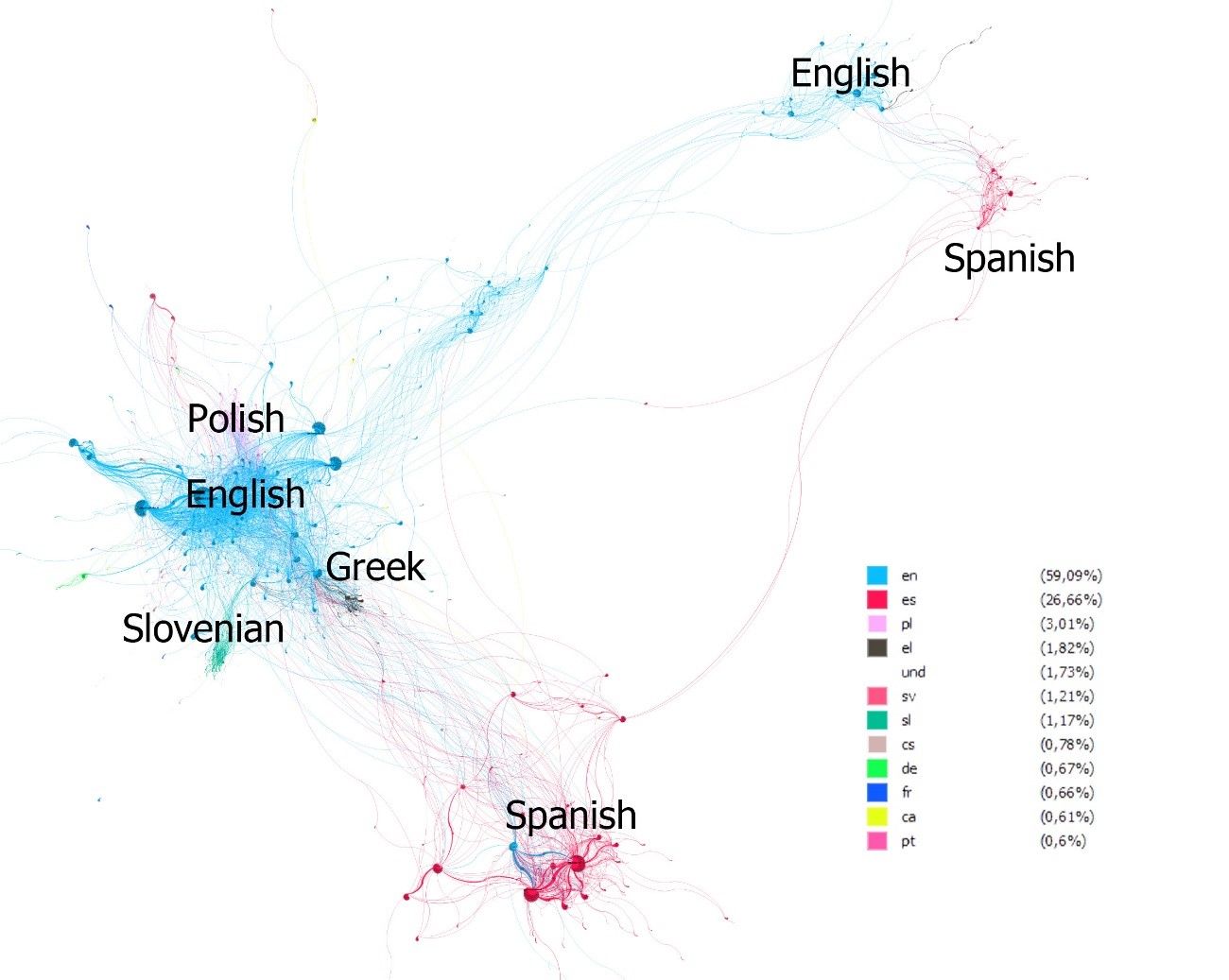
The organisation of this linguistic distribution also responds to similar communities, resulting in the segregation between two Spanish-speaking segments and two Anglophone segments.
Graph 2 shows three weakly connected zones demarcated at times by language and at times by ideology. The main zone (the left part of the graph) corresponds to a block of English-speaking communities supporting the celebration of the Day of Remembrance for Victims of Authoritarian Regimes, with profiles from Lithuania, Poland and other parts of the EU, as well as Canada and Hong Kong. Of these, the Auschwitz Memorial and the EU are the institutions generating content. Another block (bottom left part), also a support block, is made up of Spanish-speaking communities with users from Spain and Venezuela, with a notable presence of right-wing groups. The third group (upper right part) is separated by the ideology opposing the previous trends in defence of the celebration and they bring together profiles that use English and Spanish and deny the existence of victims of Stalinism. In the middle of both polarised segments we can observe small communities, which in the Anglophone part represent positions against the government of Canada and in the Spanish-speaking part represent the Spanish political left. The dissemination between identifiable communities has been very disperse, with almost 22.49% of the profiles belonging to isolated groups or groups which contained less than 3% of the participants. In the analysed graph, the communities are also very fragmented, with the largest one being a group of profiles from Spain with 10.94% of the profiles and another from Lithuania with 10.27%. The other groups have less than 10% of the users.
Graph 2. Distribution of ideological communities
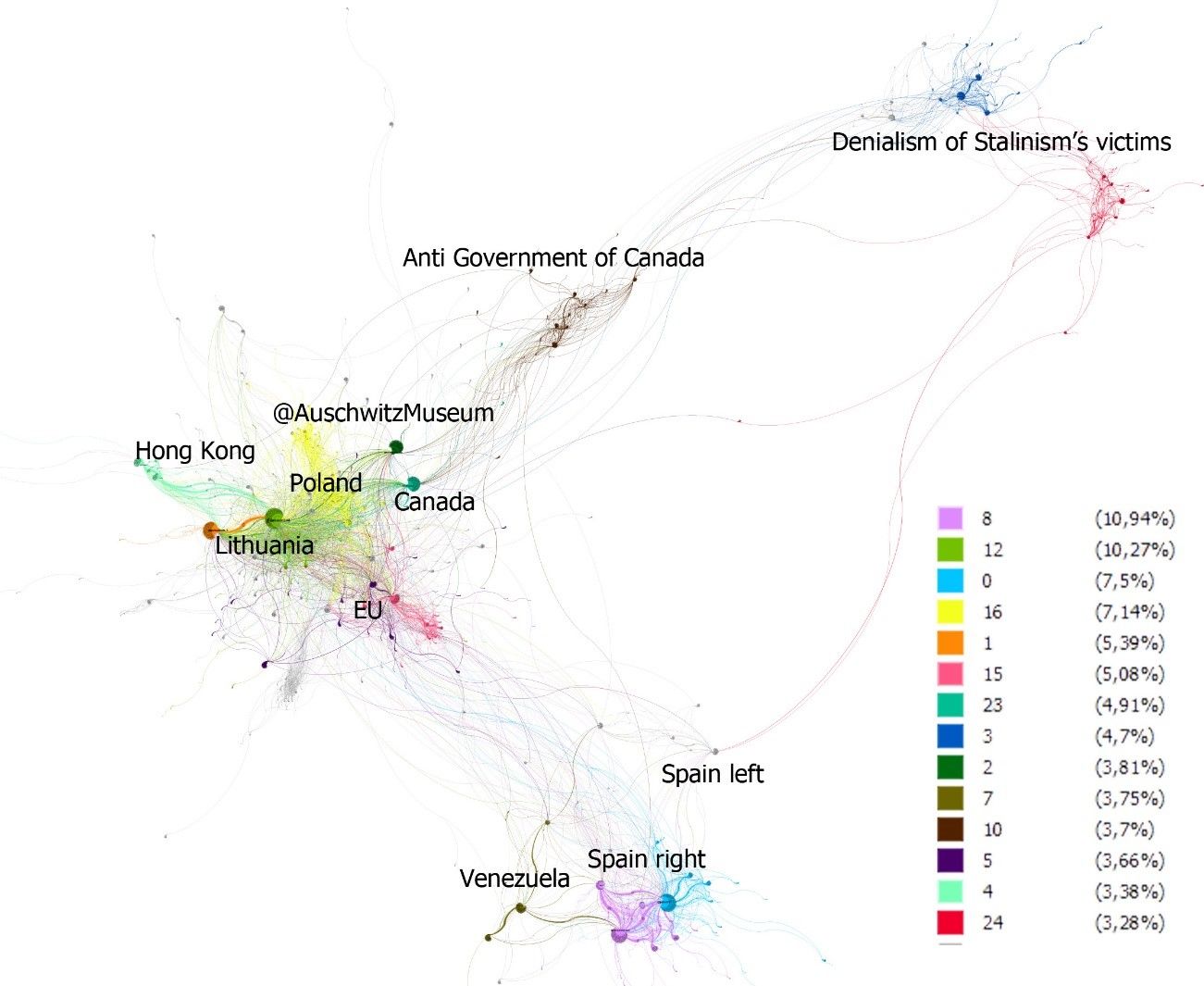
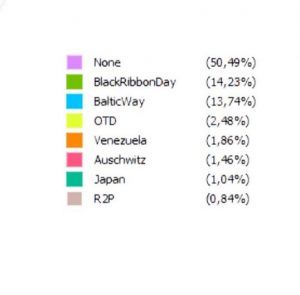
The majority of the tweets did not include hashtags. The most frequent tag was #BlackRibbonDay present in 14.23% of the tweets. The second was #BalticWay with a presence of 13.74% and mainly representing the Lithuanian community, which interacts with the celebration through its own foundational historical event. The third was #OTD, an acronym of “On This Day”.
Graph 3. Time distribution of the contents according to tags
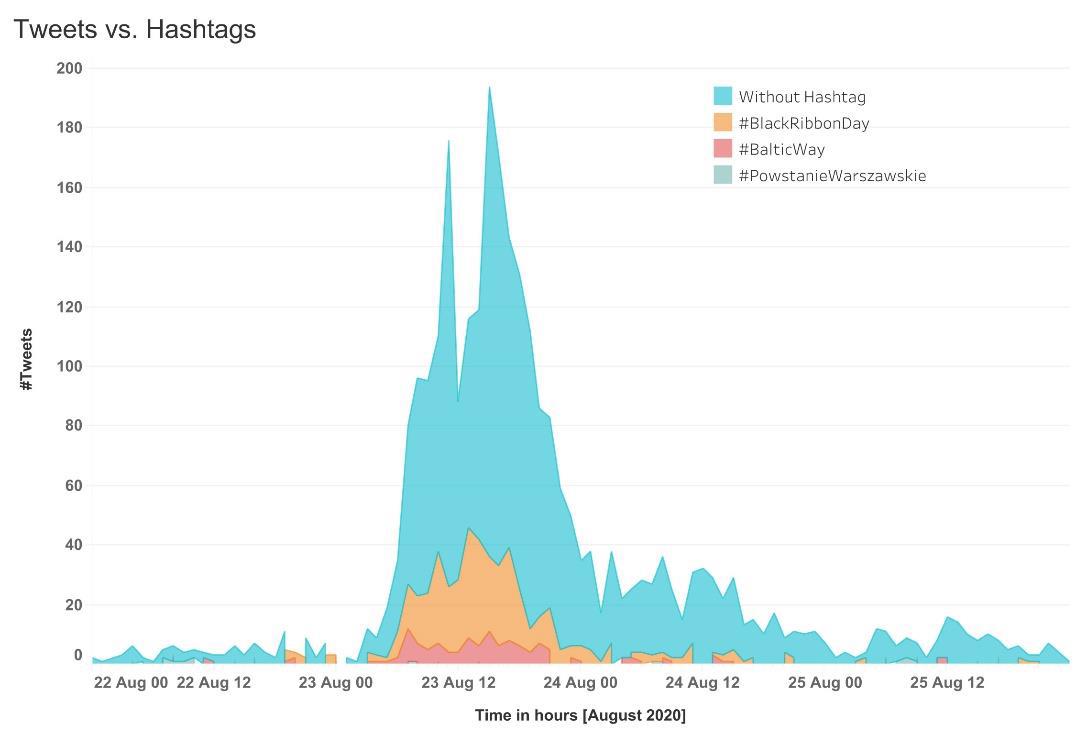
In terms of contents, the 10 most shared messages throughout the day belong to the group reclaiming the celebration, among whom most notable are Spanish right-wing politicians, such as the president of the Assembly of Madrid, Juan Trinidad Martos, and the journalist and politician from the far-right party Vox, Hermann Tertsch.
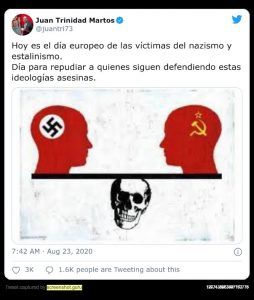
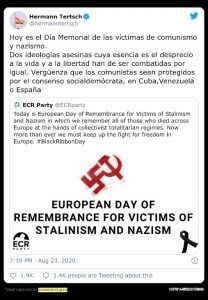
We also find contents generated by European institutions, such as the EU Council account, the European Parliament and the ECR Party. And politicians from Canada (the member of parliament, Chrystia Freeland) and Venezuela (Tama Suju, Venezuelan opposition).
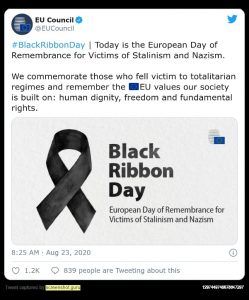
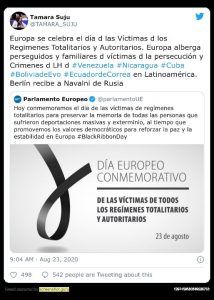
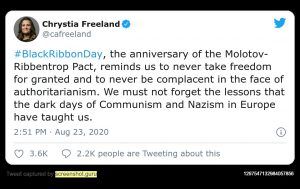
We can also identify related contents which reclaim the Baltic Way, such as the tweet by Linas Linkevičiuso (Social Democratic Party of Lithuania), and the Hong Kong protests.
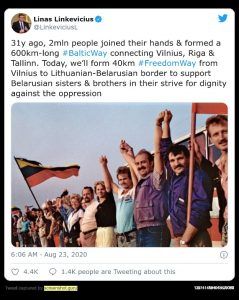
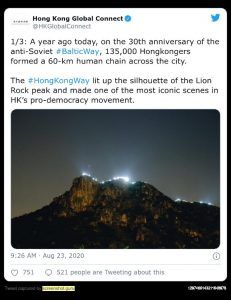
We also find tweets that oppose the comparison of memories of Nazism and communism. These tweets, in general, were generated by anonymous profiles and are notable for their institutional or political absence. This community represents a growing force that appeared in 2020 and that shows the open conflict and the interpretation problems which, since its beginnings, have accompanied this celebration.
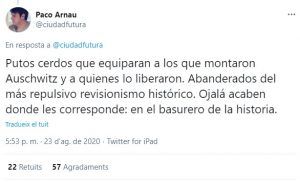
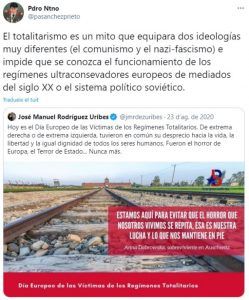
Day of Hispanicity 2019 and 2020
The analysis of the Day of Hispanicity is new in this report, and by including it we seek to further explore the social phenomena surrounding this date. As we have indicated, it is not an intrinsically European celebration, but it has implications and readings that go beyond the borders of the Spanish and American states amidst a debate about racism and colonial legacy [4]. Consequently, it can be relevant to understand the reach of movements such as #BlackLivesMatter, among other emerging movements. In this analysis we have collected data from 2020, but we have also retroactively collected data from 2019, and as such it will be a comparative reading that will show how the date takes on a new meaning in every context.
From the outset, the difference in the volume of contents generated online between one year and the next must be highlighted. While in 2019 there were 33,740 tweets (which reached an impact of 134,462 through RT), in 2020 there were 105,952 tweets (with a total reach of 594,954 through RT). This represents a threefold increase, and we must also bear in mind that as a result of a sampling error in 2020, the tweets that included the word “Hispanidad” without a hashtag were not tracked —which would probably have resulted in an even higher number [5]. Therefore, in this last year, the activity was much higher. The reason is probably the different circumstantial events that accompanied the celebration. On dates close to the celebration of October 12th 2019, in Ecuador riots broke out in the protests against the removal of subsidies for fuels, decided in the framework of an agreement with the International Monetary Fund (IMF). The Ecuadorian government declared a state of emergency with a curfew. This exceptional situation was reflected in the tweets on October 12th published on those dates. In Spain, during the military parade that is held every year on this date, a parachutist collided with a lamppost when performing manoeuvres. This incident gave rise to many jokes as well as support for the parachutist. On the contrary, in 2020, the celebration of October 12th was marked by the health crisis caused by COVID-19. Likewise, and in a cross-sectional manner, parallel celebrations have become institutionalised with a view to deviate the focus of the idea of Hispanicity and focus them on colonisation, with the “Day of Indigenous Resistance” [6] being the most notable, coinciding with October 12th both years.
Another difference between the two years is the cohesion of the communities. In 2019 they were more disperse, since the eleven largest groups represented 68.11% of the nodes in graph 1. However, in 2020, the thirteen communities identified represented 80.3% of the profiles. However, the polarisation between them is evident in both years, with some differences.
If we analyse the graph of communities from 2019, the largest community corresponds to profiles from Venezuela and Ecuador with 15.68%, followed by two communities of a similar size, 9.23% and 9.05%, corresponding to a Spanish far-right group and an Ecuadorian group. The polarisation occurs in the left-right axis, with opposing messages about accounts of Hispanicity. The largest zone (top part of the graph) corresponds to a group of Ecuadorian and Venezuelan profiles which are in favour of celebrating the Day of Hispanicity. On the left there are conservative Spanish profiles separated into two groups, one more radical than the other. On the bottom right part, from left to right, there are Venezuelan profiles that are close to the government, Venezuelan profiles supporting the indigenous resistance, Ecuadorian profiles tweeting about the curfew, an Ecuadorian group with a more varied discourse, a group against the celebration of the October 12th and a Catalan pro-independence group against the Day of Hispanicity.
Graph 1. Communities of 2019
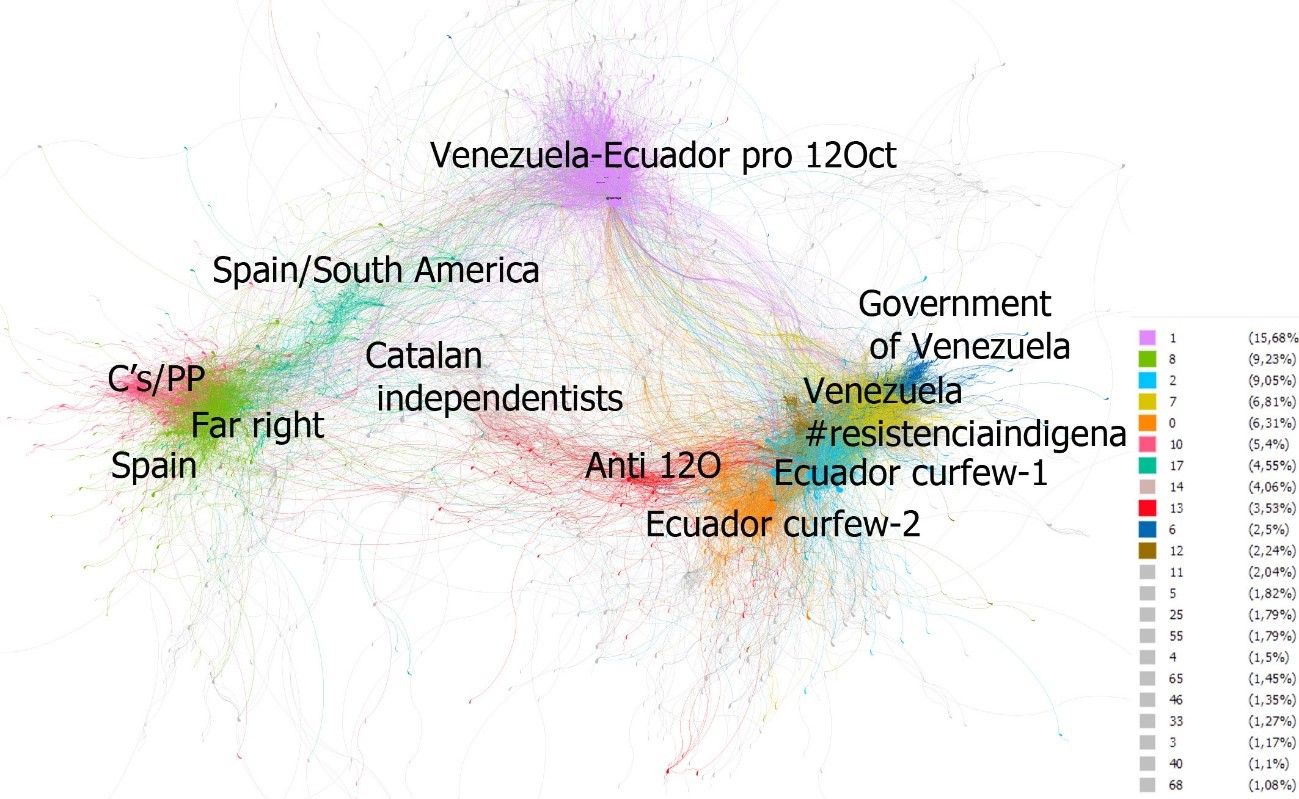
The messages most shared that day were in relation to the protests in Ecuador and used the tag #12Oct. The other highest number were those of the Venezuelan opposition reclaiming the Day of the Race or critics of Podemos in Spain.
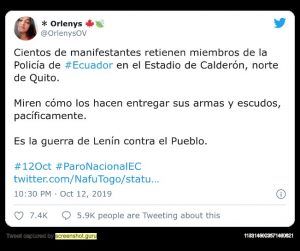
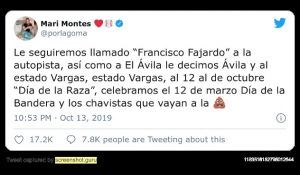
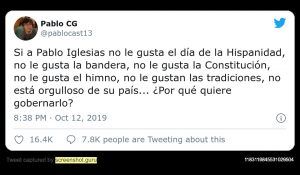
We also find messages that criticise October 12th and claim indigenous resistance. Also, from the Catalan independence movement, since although the predominant language in 97% of cases was Spanish, Catalan also had a moderate presence of 2%.
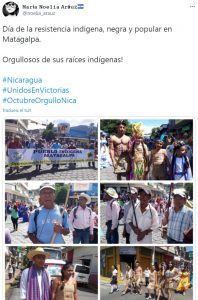
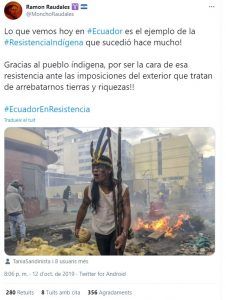
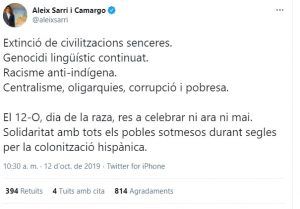
There was also satire and memes surrounding the incident of the parachutist who collided with a lamppost during the Spanish military parade, with the tag #Diadelafarola spreading.
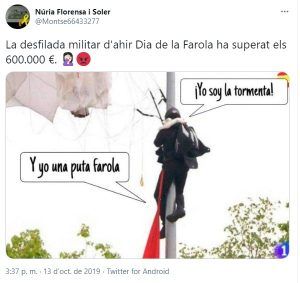
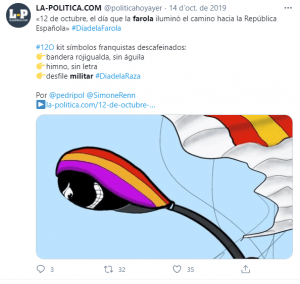
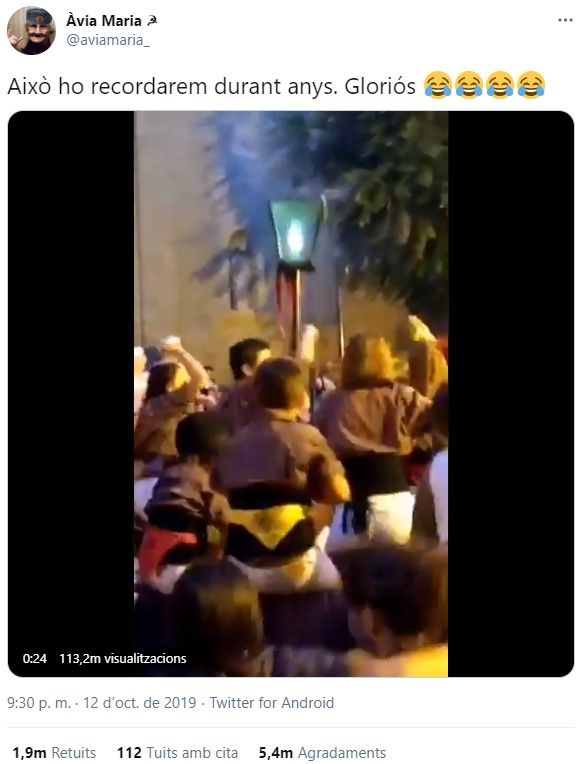
Video showing a group of people, mainly pro-independence, singing the song “la farola” (the lamppost) as a satire of the occurrence.
In 2020, on the other hand, despite the similar polarisation between the communities, there were more connections and dialogues between them, probably as a result of the higher volume of information generated. In graph 2, the three largest groups are from Spain, the largest (20%) mainly represents young people against messages from VOX. They are followed by a radical right-wing group (14.06%) and another “radical” left-wing group (9.75%). The rest of the groups are from Latin American countries and to a lesser extent Spain.
Graph 2. Communities of 2020
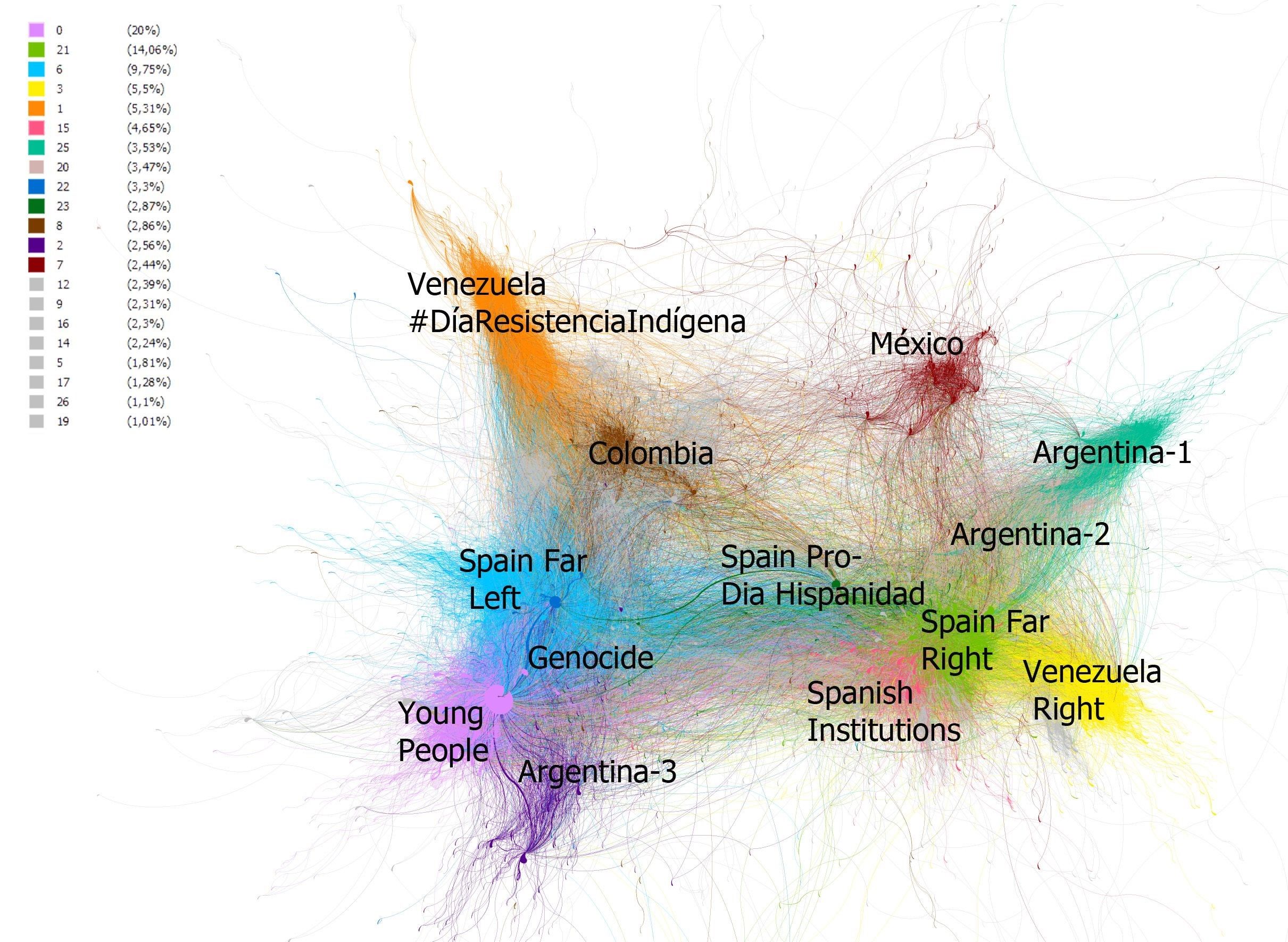
The graph shows various zones connected to a central group which denied that the conquest of America by Spain was a genocide. The communities located on the left issued messages against the celebration of the Day of Hispanicity and those on the right, apart from group Argentina-1, were in favour of this celebration. The most overwhelming messages against the celebration of the Day of Hispanicity were from a group of various countries, which compared it to genocide, and which used the tag #nadaquecelebrar —the previous year this group mainly used #resistenciaindigena. The use of multimedia and of striking explicit drawings in the form of memes also increased. An increase in the trend to use the quote to criticise a message was also observed. This trend will increase with the new Twitter interface which favours the quote over the RT. Lastly, it is important to highlight that this year there was a decrease in Spanish, which reduced to 91%, with the use of Catalan and English increasing moderately.
Among the messages in favour of the celebration, there are diverse stances. The Spanish right-wing stance reclaims the heroic deed of colonisation and the celebration of the day despite the health restrictions in the second wave of COVID-19. We also find messages from the Venezuelan opposition in favour of the celebration.
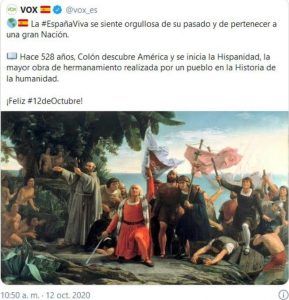
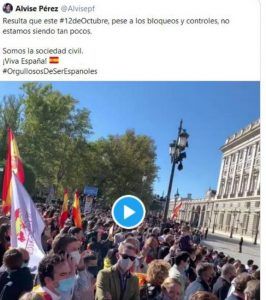
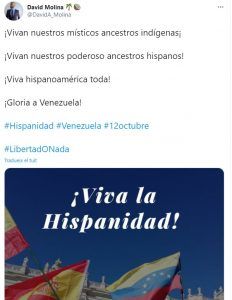
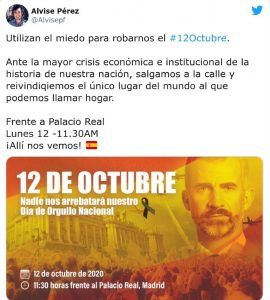
Within this favorable stance, but moderately and in reference to the National Day of Spain, we find institutional messages from the Government of Spain. Far from the subject of Hispanicity, the government issued messages about the COVID-19 pandemic which, without question, defined the political agenda of the year.

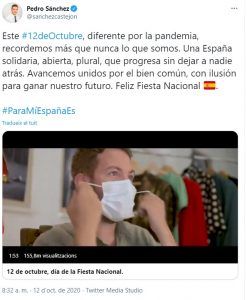
However, there were many opposing messages, critical of the subject of colonisation and of glorifying Hispanicity, and in favour of the colonised people. Messages shared from Spain, especially by left-wing and pro-independence groups, and Latin America —more hegemonic, apart from the Venezuelan and Argentinian right. The references to the terms genocide, indigenous resistance, destruction of monuments and criticism of the right for its attitude to the pandemic, were constant. Therefore, their narratives mixed the present context with the historical wave of opposition to the date, especially from 1992 onwards, with the 500-year anniversary of the colonisation.
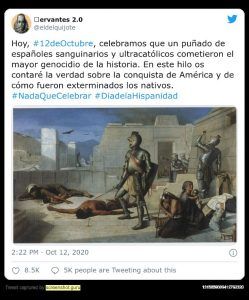
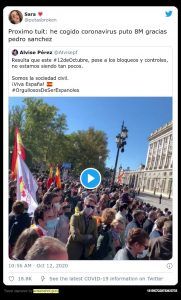
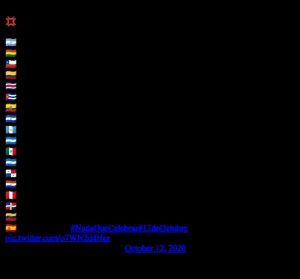
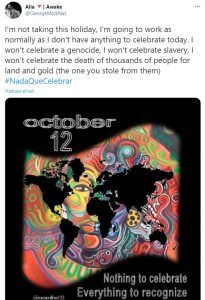
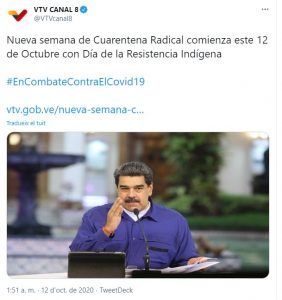
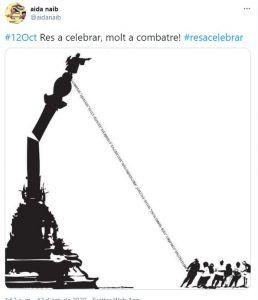
There were also numerous references to #BlackLivesMatter, using Columbus Day (in the USA) which is also celebrated on October 12th, and which was widely opposed on the streets. This phenomenon, which started with the death of George Floyd at the hands of the police, triggered a protest movement against institutional racism which, ultimately, concentrated its actions on the statues of conquerors in the public space. October 12th represented a battlespace within the logics of this antiracist movement.
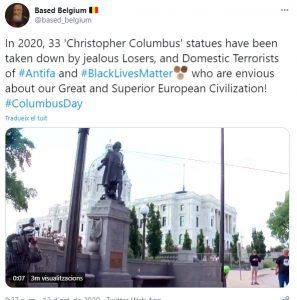
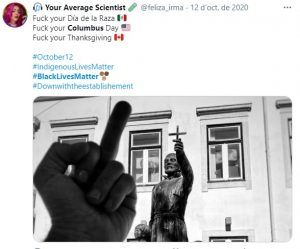
Day in Remembrance of the Victims of the Franco Regime
At the beginning of 2020, the coalition government of PSOE and Unidas Podemos agreed to declare October 31st as a day of remembrance for all the victims of the Franco Regime and May 8th to recognise victims in exile [7]. This year, however, there has been little institutional support and the event went by unnoticed, as least on social media. The creation of a celebration needs institutional support, although fundamentally it needs support from the people. As we have seen on previous occasions, in European celebrations such as Europe Day, the institutional initiative is not sufficient if there is no sentiment of reference. A key example is April 14th, also analysed previously, which, despite being a popular and extraofficial celebration, receives huge support from citizens. In short, the future of this celebration will depend on two elements: on the focus given to it by the media and the intuitions and popularity it has among the people.
If we focus on its development this year on Twitter we can observe that there was little content creation, which meant we had to widen the search parameters and include the term “franquismo”. Despite this, only 5,411 tweets were recorded (with a reach of 23,802 through RT). Moreover, dissemination through communities was very disperse. The fifteen largest groups represent 66.69% of the nodes, the rest are groups with less than 2.5% of the users. In the graph analysed, the communities are also very fragmented, with the three largest ones being a group of profiles from the far-right and two from the left (graph 1). The dominant language was Spanish (98%). However, we must also consider that words in Catalan, Basque and Galician were not included in the search parameters.
Graph 1. Distribution of communities.
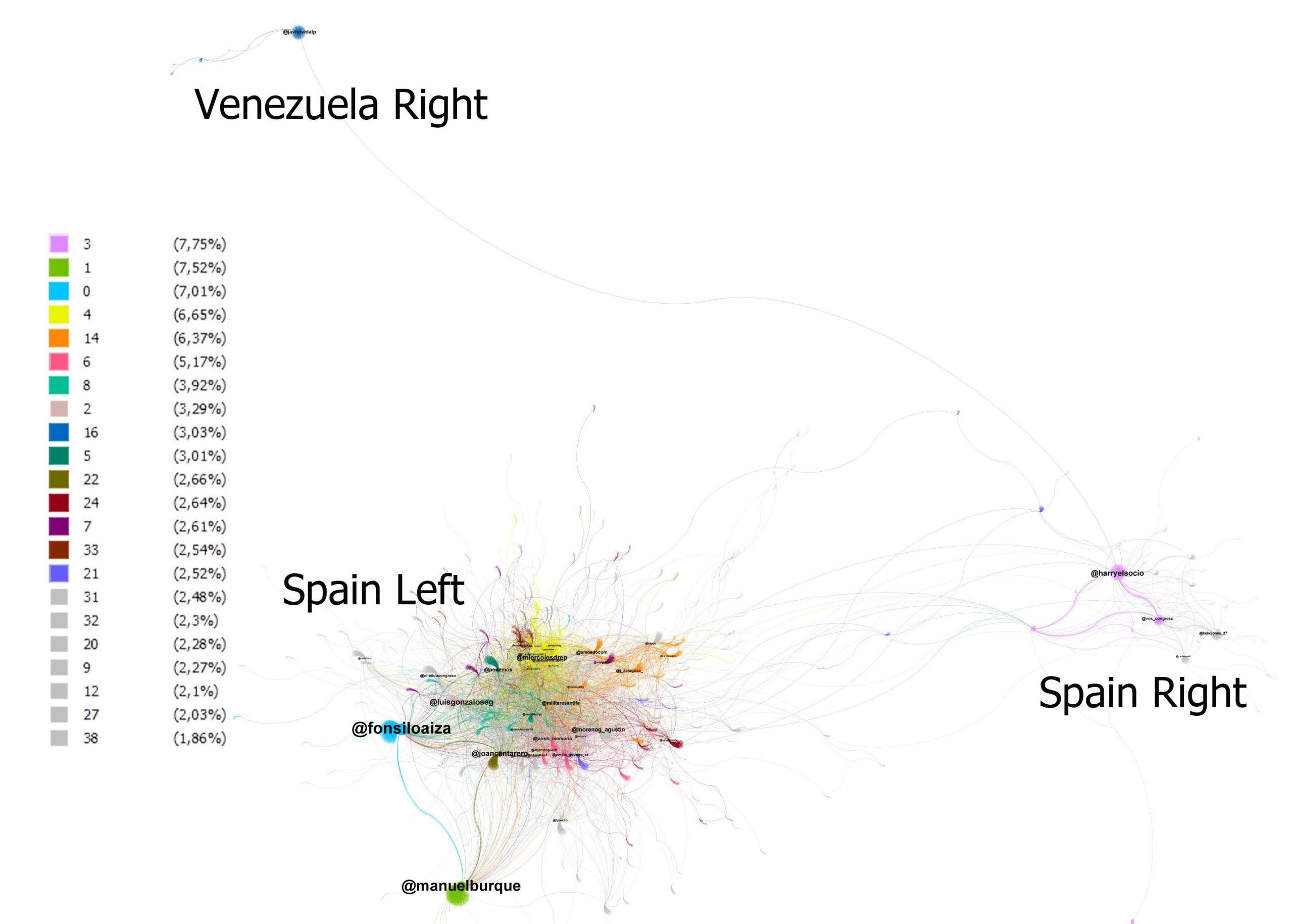
The graph shows three weakly connected zones, demarcated at times by geography and at times by ideology. The large part (lower left part of the graph) corresponds to a group of Spanish profiles with a left-wing ideology. The second group corresponds to far-right profiles (situated on the right of the graph). In the upper left part there is an opposition group from Venezuela proposing a transition in their country like that which occurred in Spain, from the Franco Regime to democracy. The majority of the tweets (85.75%) did not include hashtags (Fig. 4) which reveals that there was no organisation around the commemoration of this day. The hashtags that appeared are not related to the celebration of the day.
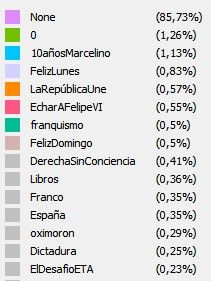
Fig 1. Distribution per tag.
If we focus on the contents, we can affirm that they were disperse and disjointed. There was no unifying initiative or previous socialisation, and consequently the majority of the tweets that day were related circumstantially —by referring to Francoism— but not directly.
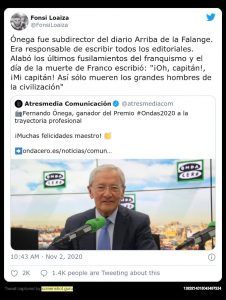
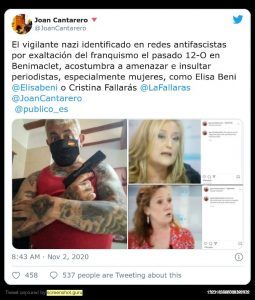
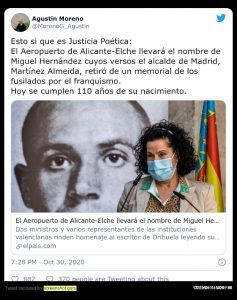

The institutions did not refer to it, apart from a tweet by Podemos which does not directly refer to the celebration.

There was not much impact among the right either. The notable tweets do not focus their discourse on the celebration but on the defence of Francoism and its glorification.
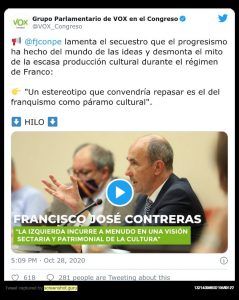
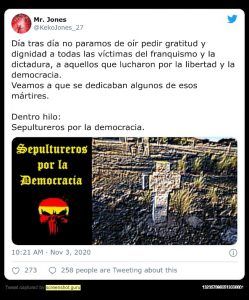
[3] See: https://europeanmemories.net/eurom-new/publications-and-res/report-online-memories-1/
[4] October 12th is the date of Christopher Columbus’ supposed discovery of America. It became a national celebration from the end of the 19th century onwards in Spain, under the concept “Hispanicity”. Said celebration has since spread to the majority of the American republics, under different formulae, although Hispanicity was the most widespread —for example, in the United States it has been historically know as Columbus Day. During the Franco regime it became known as the “Day of the Race”. Currently in Spain it is the “National Feast Day” and in some Latin American countries the “Day of Indigenous Resistance” is celebrated, to oppose the historical glorification.
[5] The tag #BlackLivesMatter was not included in the search criteria either. It generated related content —although not only about the celebration.
[6] Official celebration in Venezuela and Nicaragua; in Argentina the “Day of Respect of Cultural Diversity” is celebrated, opposing the Day of the Race or of Hispanicity.
[7] https://elpais.com/politica/2019/12/30/actualidad/1577736147_473600.html

